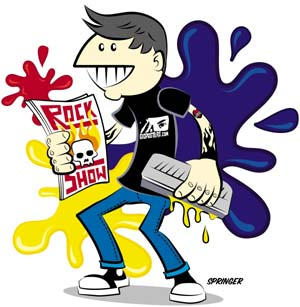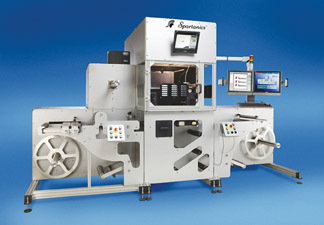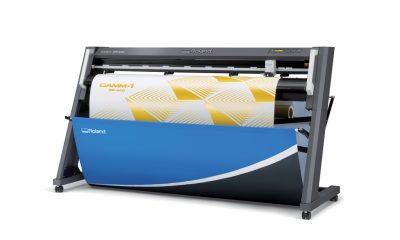Graphics Printing
Published
19 years agoon

We all know about Sara Serigraph, the darling debutante daughter of Mr. and Mrs. Silkscreen. She’s a creature of rare beauty, elegant with expensive tastes, and found only in the company of better galleries, art societies, and true connoisseurs of the printed form.
We all know about Sara Serigraph, the darling debutante daughter of Mr. and Mrs. Silkscreen. She’s a creature of rare beauty, elegant with expensive tastes, and found only in the company of better galleries, art societies, and true connoisseurs of the printed form.
This tale, however, is about Sara’s long-lost brother, Johnny Gigposter, who ran off and joined a rock n’ roll tour that passed through town when he was just a kid. Johnny spent his formative years skating, surfing, and hanging out with punk, metal, and grunge bands and experimenting with illicit art in the form of concert flyers. He was run out of Seattle, Austin, and other cities by the poster police, but he somehow managed to not only survive, but also to develop some awesome artistic talent along the way. And now the prodigal poster boy has returned to claim his place in the mainstream art world, squeegees dripping multicolored ink like a new-age gunslinger in all his Day-Glo glory.
Okay, that may be laying it on a bit thick, but those of you who’ve been stopped dead on the street by a poster advertising some band or concert event, sporting a design that grabs your eyeballs and doesn’t let go, you know what I’m talking about. Rock concert posters–gigposters, in the vernacular–are an imaginative, visual representation of a band, its music, or both, but not usually in a literal sense. These aren’t just offset-printed photos of the artist with some type on the side for a teenybopper’s bedroom wall. Leave that for the mass-marketed pop stars. Today’s modern rock posters are original works of limited-edition art (Figure 1).
Gigposters showcase the creative artist/printmaker’s skills in illustration, design, and cartooning, mixed in with computer savvy and, often, old-fashioned graphic ability, including hand lettering and killer ruby-cutting talent. Some are printed digitally, some offset, some letterpress, but most are screen printed, either by the artist or a printer who specializes in the form. The lowly music poster has transcended its original purpose, which was to attract, inform, and then motivate the viewer to go to the gig. It now has become collectible art.
The contemporary music poster is part ad, part merchandise, and part fine-art print. It’s produced in small quantities, signed and numbered by the artists, and sold at art shows as a limited-edition piece. The more famous posters, by established artists such as Frank Kozik, Jeff Wood, Jermaine Rogers, Emek, Art Chantry, Linsay Kuhn, Jay Ryan, and a host of others, are available in galleries, from the artists’ Websites, secondary print markets, or eBay, where rare prints sell for thousands of dollars and counterfeits are starting to turn up. Today’s poster artists are the second wave of the rock-art movement, taking up the torch from the likes of Mouse, Kelly, Hipgnosis, and others from the 1960s and ’70s.
United by the Internet
The growing number of individuals and design groups who produce gigposters are scattered in cities and towns across the US, Canada, and other countries. You may know some of them in your area, or they may work in your shop or for one of the graphic-design firms that give you work. They could be anywhere there is a music venue that needs posters–in big cities producing posters for local club and coliseum events or in small towns printing posters for bands and events all over the world.
The artists behind this movement have become linked and united in the past few years by the Internet, mostly through a Website called–what else–gigposters.com. The site is operated by Clayton Hayes, an enterprising fan of the rock poster from Calgary, Canada. Hayes, a Web designer and musician, launched the site in 2001 and watched it grow into a virtual club-house with 34,500-plus posters on file from more than 3100 artists and designers worldwide.
"I am so excited every time I log onto gigposters.com and see the volume of new art and artists who are getting into the field," says Leia Bell, a Salt Lake City, UT-based artist. "When I began, I had no idea there were so many people out there doing the same thing as me, because I was the only one I knew of in my town. I knew all the big-name artists, of course, but when I finally discovered gigposters.com, I was blown away by all the different styles, methods, and areas of the world where poster art was making a comeback."
Bands use gigposters.com to find designers, designers use it to find bands, and almost everyone uses the forums to stay in touch, pass on information about poster shows and exhibitions, and criticize and praise the latest posters from around the world, look for inspiration, or participate in sometimes rude, oftentimes crude, but always interesting, discourse on music, art, and life. "Gigposters. com is a good example of how the Internet is supposed to work," says Frank Kozik, one of the icons of the movement and the first president of the American Poster Institute (API).
The Art of Modern Rock salutes screen printing
A new book, entitled The Art of Modern Rock: The Poster Explosion, from authors Paul Grushkin and Dennis King, has just been released. It has already been selected as one of the top 10 modern pop-culture books on Amazon.com for 2004. It chronicles the growth of the gigposter art movement from the late 1980s as it leapfrogged and spontaneously erupted across North America and around the world. Visually stunning, well written, and destined to break the 250,000 print-run record set by its predecessor, the Art Of Rock, which is the definitive collection of poster and album-cover art from the 1950s to the ’80s and is the reference tool of choice among collectors worldwide.
The Art of Modern Rock tells the story of the artists–rock music fans, every one–who diligently pushed, prodded, and dragged the humble, photocopied black-and-white music poster from lampposts and store windows into the current multicolored incarnation we find in high-end art galleries and in the homes of both music fans and serious art collectors. The book also explores the role of screen printing, which many of the artists embrace as their printmaking technique of choice.
The first two chapters in The Art of Modern Rock trace the people and events behind the re-emergence of the concert poster and look at why screen printing and modern rock posters are so tightly linked. Whether the posters are printed on semiautomatic presses with UV-curing units in larger print shops, such as Portland, OR’s Diesel Fuel Prints, D&L Screen Printing in Seattle, WA, or Drowning Creek in Commerce, GA, or manually produced with latex house paint on homemade print tables, screen printing is the dominant reproduction method.
Grushkin says that when he and King first reviewed the 6000 posters submitted for the book, they found that more than 80% of them were screen printed. The established designers and screen printers who worked in the field during the last 15 years have inspired hundreds of new artists to explore the screen-printing process. The net result has been an explosion of DIY screen printing happening on kitchen-table clamshells and in basements and garages across the land.
Aside from delivering eye-popping colors, part of the explanation for the popularity of screen printing is its low entry cost and simplicity. That’s attractive to young people or starving musicians, who can’t afford a big budget for their posters. "After I graduated, screen printing was the only method I could set up in my home on a poor college student’s budget and whip out artwork at a rapid pace," Bell says (Figure 2).
Readers should note that the bulk of gigposters are not done as typical, paid jobs. The artist gets permission from the promoter or the band to produce and sell posters for a specific gig, so they are mostly done on spec. The upside for the artist is virtually full artistic license. The artist can create a unique vision to illustrate the band and its music. The downside is minimal budget, which makes screen printing an attractive technique. Even the bigger shops find it more economical to use.
Steve Horvath (Figure 3), owner of D&L Screen Printing, says his current main press is a semiautomatic Sias machine with a print size of 24 x 35 in. D&L is considering a new Thieme machine to keep up with demand. He uses an Epson 7600, a 24-in.-wide printer, to produce the shop’s film positives. "This is one area where new technology is actually making screen printing easier, less time consuming, and much less expensive than, say, 10 years ago," he says. "Computers, which were initially going to make screen printing almost obsolete, are actually helping to make it easier to work with art files and get them ready to be printed."
Some designers, like Gary Houston of voodoocatbox.com in Portland, OR, enjoy the tactile feel of the squeegee in the ink and screen printing’s immediate and self-contained nature. He is an old-school poster maker, whose intricate and beautifully printed designs are, for the most part, cut using Rubylith. He stays mechanically simple by choice, comfortable with his manual setup and basic work area. The sale of only a few of his classic prints could buy a nice automatic, but he prefers using his hands for maximum control. He explains his philosophy on screen printing this way: "The fabric on a screen is like life. Sometimes it rips easily, or sometimes it lasts a long time."
Andy Stern, who runs Diesel Fuel Prints, a full-service shop that prints T-shirts, stickers, and posters for many of the artists, started in screen printing 22 years ago. "Back in my punk-rock youth, it was the only way to get something on the back of your jacket. There was a huge DIY movement in D.C. back in those days, so learning the craft seemed to be the only way," he recalls. "I love the smell of the ink, especially when slathered all over my body. One of my friend’s older siblings introduced screen printing to us. Really I just do posters for fun to take my mind off normal everyday production."
"In my opinion, screen printing is the most effective medium for rock posters," says Michael Hammond, a printer from Pasadena, CA. "I started out making digital offset posters and they didn’t have the tactile feel of screen-printed posters. After exhibiting digital posters at my first Flatstock, and then seeing all the great screen printing by the other artists, I went home and signed up for a screen-printing course the next day. I’ve now got a semiautomatic crammed into my studio. I really enjoy the process of screen printing in that the end result is made completely by my hand. It is much more like painting than computer-generated posters," he says.
Flatstock: The ultimate poster show
Last September, I traveled to the annual Bumbershoot Music Festival in Seattle to attend Flatstock 5 and meet some of the artists and printers who create all of this great work. Sixty booths featured nearly 100 API artists from across the USA, Canada, and from as far away as Australia (Figure 4). The original Flatstock took place in San Francisco and has been growing in popularity and attendance ever since. Brian Taylor, the head printer at Seattle, WA-based Patent Pending Inc., who along with partner Jeff Kleinsmith, art director at Sub Pop Records, hosted a reception for the exhibiting artists and guests at their Seattle print shop, explained how the name Flatstock came about.
"[Frank] Kozik was helping with a show in San Francisco. He brought it up on gigposters.com and there was a ot of interest, so he decided to make it a little bigger. It ended up being held at the Cell Space in San Francisco. That was the start of something much bigger and much better. He posted a thread on gigposters.com asking for names for the show. Had I known that my selection of ‘Flatstock’ would become this big, semi-annual poster convention, I might have asked for more than the right to be smug, which is what Kozik said the winner would get."
Geoff Peveto, an Austin, TX-based graphic designer and current API president, expands further on the show’s development. "Kozik is responsible for both Flatstock and API. One day in 2002 he just said, ‘If I throw a poster show in San Francisco, how many of you will show up?’ About 30 of us made the trip. Frank and I were talking about what to do next, and I suggested approaching South By Southwest (SXSW, a large music-industry conference held in Austin, TX). Frank started up the API right before I knocked on their door, and SXSW was more inclined to entertain the idea of a poster show with an organization like the API sponsoring it. Since then, the API has grown to more than 300 members, and we’ve caught the eye of Bumbershoot and have been lucky enough to move the show between SXSW and Bumbershoot."
The Flatstock event has now morphed into a combination exhibition, sales opportunity, and a chance for the members of the poster-making community to get together in one place. Right now, Peveto and the Austin contingent are in the preliminary stages of organizing Flatstock 6. "At the last one, we held a screen-printing workshop by Ron Donovan and Chuck Sperry from Firehouse Kustom Rock Art and a stencil workshop by Mig Kokinda," he says. "We plan on continuing those and we are talking about what to add to the event. The dates are for sure though: March 18 and 19 in Austin."
Inspiring innovation
I’ve always loved rock posters and, having played in bands and promoted music shows over the past 30-plus years, know their power as an advertising tool. As a screen printer, I appreciate the technique and art-production skills that go into producing these images. What knocks me out about the gigposter art movement is the innovation it brings to our industry. One example is real-time promotion of a print run. The fine-art market could learn something here. Artist Frank Kozik, working with Andy Stern at Diesel Fuel, shot and posted digital images of a print run in progress on message boards, where collectors were able to place their orders and pay electronically. As the print run progressed, the orders came in, driven by the images and the constantly declining number of prints available. The run was sold out before it was completed.
Here’s another example: Screen-printing ink is hard to come by for novice printers on tight budgets or those stuck in remote locations without suppliers nearby. These folks have innovated by using latex house paint as ink. A trip to the local paint store can usually score the printer some interesting and very cheap mistints (colors that were either made incorrectly or failed to meet the customer’s expectations). From there, the poster artist mixes in a clear base and an additive, like Floetrol, that improves the paint’s flow and extends its working time. This movement is revolutionizing DIY screen printing worldwide.
True to their technique
When you get to know some of today’s gigposter artists, you realize many of them have day jobs. Interestingly, lots of the part-time printers I met are mainstream graphic designers, some of whom feed jobs to commercial screen printers on behalf of their Fortune 500 clients. These artists not only know how to design for screen printing, but they also promote it over other methods. By clearly illustrating screen printing’s potential in their work and inspiring others to become interested in the process, gigposter artists are helping to keep screen printing in the forefront of imaging techniques.
Author’s note: Thanks to Paul Grushkin, co-author of the Art of Modern Rock, for background information on the rock-poster movement and Dan Springer for providing the "Johnny Gigposter" illustration.
About the author
Andy MacDougall operates a screen-printing studio in the Canadian city of Courtenay, British Columbia. From a start as a printer’s apprentice his background grew to include positions as a marketing and sales director for a multinational graphic-equipment manufacturer and a printing-business owner. His current focus includes printing limited-edition art, developing low-toxicity print practices and techniques, conducting workshops and training seminars, and consulting for manufacturers. Visit him online at www.squeegeeville.com.
Online resources
If you can’t make it to Flatstock, visit the following Websites to find out more about the art and the artists behind the gigposter movement.
www.gigposters.com Featuring ‘Poster of the week’ and new submissions from around the world daily, this is a good place to start. Also has direct links to more than 3000 individual artists.
www.artofmodernrock.com View some of the more than 1800 posters by 375 of the world’s top artists, from Bosnia to Boston, in this heavyweight, full-color art book. Available through major booksellers nationwide.
www.americanposterinstitute.com The API is an association for professional artists, printers, and supporters. It organizes the Flatstock events and provides information, product reviews, and peer support (legal, technical, suppliers) for its growing membership.
Artists and print shops featured in this article
Leia Bell Salt Lake City, UT www.leiabell.com
Andy Stern Portland, OR www.dieselfuelprints.com
Brian Taylor Seattle, WA www.patentpendingindustries.com
Geoff Peveto Austin, TX www.thedecoderring.com
Michael Hammond Pasadena, CA www.michaelmichaelmotorcycle.com
Steve Horvath Seattle, WA www.longtoothindustries.com
Jeff Woods and Judy Gex Commerce, GA www.drowningcreek.com
Gary Houston Portland, OR www.voodoocatbox.com
Frank Kozik San Francisco, CA www.frankkozik.net

Subscribe

Magazine
Get the most important news
and business ideas from Screenprinting Magazine.
Most Popular
-

 Case Studies2 months ago
Case Studies2 months agoHigh-Density Inks Help Specialty Printing Take Center Stage
-

 Art, Ad, or Alchemy2 months ago
Art, Ad, or Alchemy2 months agoF&I Printing Is Everywhere!
-

 Andy MacDougall2 months ago
Andy MacDougall2 months agoFunctional and Industrial Printing is EVERYWHERE!
-

 Columns3 weeks ago
Columns3 weeks ago8 Marketing Mistakes Not to Make When Promoting Your Screen Printing Services Online
-

 Editor's Note2 weeks ago
Editor's Note2 weeks agoLivin’ the High Life
-

 Marshall Atkinson2 weeks ago
Marshall Atkinson2 weeks agoHow to Create a Winning Culture in Your Screen-Printing Business
-

 Thomas Trimingham2 months ago
Thomas Trimingham2 months ago“Magic” Marketing for Screen Printing Shops
-

 News & Trends2 months ago
News & Trends2 months agoWhat Are ZALPHAS and How Can You Serve Them in Your Print Business?






